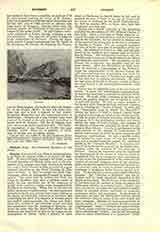

Cauchy, AUGUSTIN-LOUIS, French mathematician, b. at Paris, August 21, 1789; d. at Sceaux, May 23, 1857. He owed his early training to his father, a man of much learning and literary taste, and, at the suggestion of La Grange, who early detected his talents and took a lively interest in him, he received a good classical education at the Ecole Centrale du Pantheon in Paris. In 1805 he entered the Ecole Polytechnique, where he distinguished himself in mathematics. Two years later he entered the Ecole des Ponts et Chaussees and, after a brilliant course of study, he was appointed one of the engineers in charge of the extensive public works inaugurated by Napoleon at Cherbourg. While here he devoted his leisure moments to mathematics. Several important memoirs from his pen, among them those relating to the theory of polyhedra, symmetrical functions, and particularly his proof of a theorem of Fermat which had baffled mathematicians like Gauss and Euler, made him known to the scientific world and won him admittance into the Academy of Sciences. At about the same time the Grand Prix offered by the Academy was bestowed on him for his essays on the propagation of waves. After a sojourn of three years at Cherbourg his health began to fail, and he resigned his post to begin at the age of twenty-two his career of professor at the Ecole Polytechnique. In 1818 he married Mlle. de Bure, who, with two daughters, survived him.
Cauchy was a stanch adherent of the Bourbons and after the Revolution of 1830 followed Charles X into exile. After a brief stay at Turin, where he occupied the chair of mathematical physics created for him at the university, he was invited to become one of the tutors of the young Due de Bordeaux, grandson of Charles, at Prague. The old monarch conferred the title of baron upon him in recognition of his services. He returned to France in 1838, and was proposed by the Academy for a vacant chair at the College de France. His conscientious refusal to take the requisite oath on account of his devotion to the prince prevented his appointment. His nomination to the Bureau des Longitudes was declared void for the same reason. After the Revolution of 1848, however, he received a professorship at the Sorbonne. Upon the establishment of the Second Empire the oath was reinstated, but an exception was made by Napoleon III in the cases of Cauchy and Arago, and he was thus free to continue his lectures. He spent the last years of his life at Sceaux, outside of Paris, devoting himself to his mathematical researches until the end.
Cauchy was an admirable type of the true Catholic savant. A great and indefatigable mathematician, he was at the same time a loyal and devoted son of the Church. He made public profession of his faith and found his greatest pleasure and recreation in works of zeal and charity. He was an active member of the Society of St. Vincent de Paul, and took a leading part in founding the “Ecoles d’Orient” in 1856, and the “Association pour la liberte du dimanche”. During the famine of 1846 in Ireland Cauchy made an appeal to the pope on behalf of the stricken people. He was on terms of intimate friendship with Pere de Ravignan, S.J., the well-known preacher, and when, during the reign of Louis-Philippe, the colleges of the Society of Jesus were attacked he wrote two memoirs in their defense. Cauchy is best known for his achievements in the domain of mathematics, to almost every branch of which he made numerous and important contributions. He was a prolific writer and, besides his larger works, he was the author of over seven hundred memoirs, papers, etc., published chiefly in the “Comptes Rendus”. A complete edition of his works has been issued by the French Government under the auspices of the Academy of Sciences. Among his researches may be mentioned his development of the theory of series in which he established rules for investigating their convergency. To him is due the demonstration of the existence and number of real and imaginary roots of any equation, and he did much to bring determinants into general use. In connection with his work on definite integrals, his treatment of imaginary limits deserves special mention. He was the first to give a rigid proof of Taylor’s theorem. The “Calculus of Residues” was his invention, and he made important researches in the theory of functions. By his theory of the continuity of functions and the method of limits he placed the differential calculus on a logical basis. Cauchy was also a pioneer in extending the applications of mathematics to physical science, especially to molecular mechanics, optics, and astronomy. In the theory of dispersion we have his well-known formula giving the refractive index in terms of the wave length and three constants. Besides his numerous memoirs, he was the author of “Cours d’analyse de l’Ecole royale polytechnique” (1821); “Resume des lecons donnees l’Ecole royale polytechnique sur les applications du calcul infinitesimal” (1823); “Lecons sur les applications du calcul infinitesimal a la geometrie” (1826, 1828); “Legons sur le calcul differentiel” (1829); “Anciens exercices de mathematiques” (1826-1830); “Resumes analytiques” (1833); “Nouveaux exercices de mathematiques” (1835-1836); “Nouveaux exercices d’analyse et de physique mathematique” (1840-47).
HENRY M. BROCK

